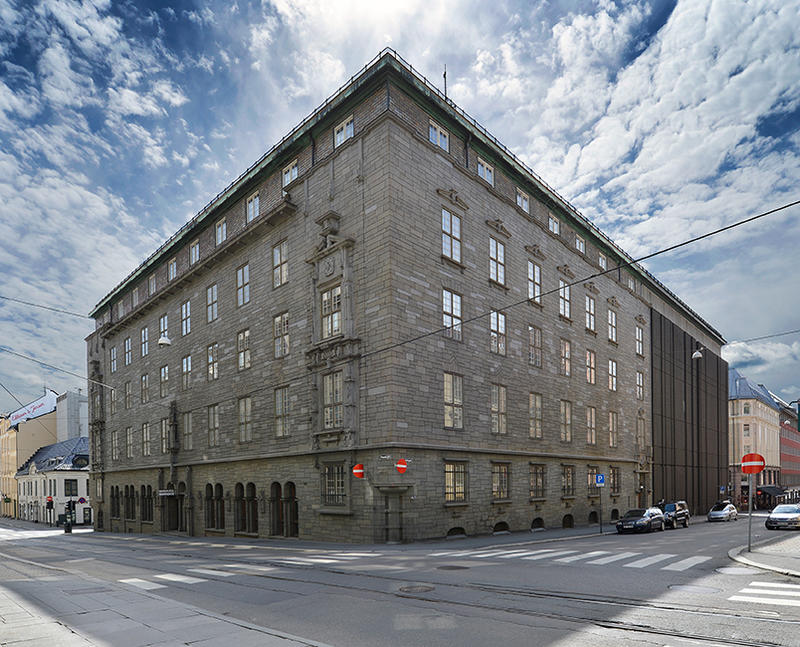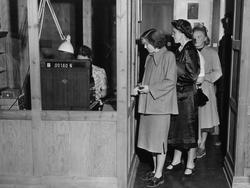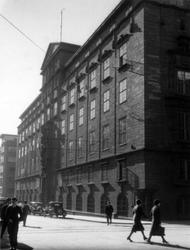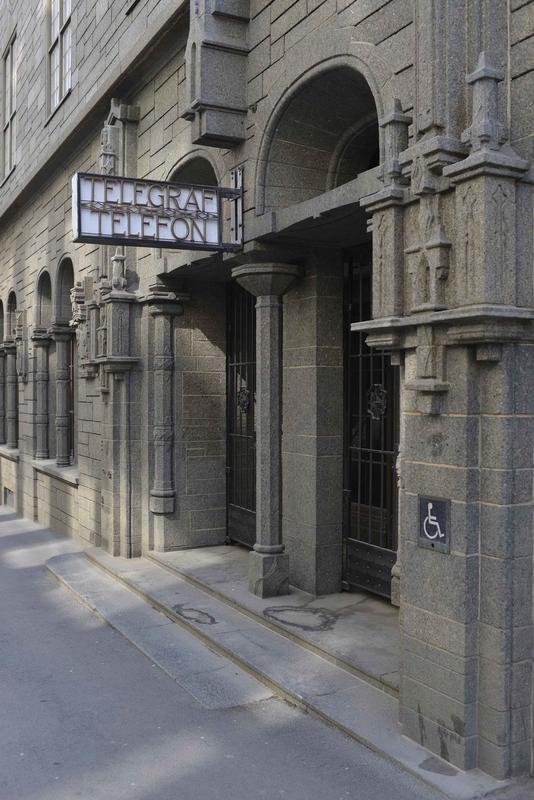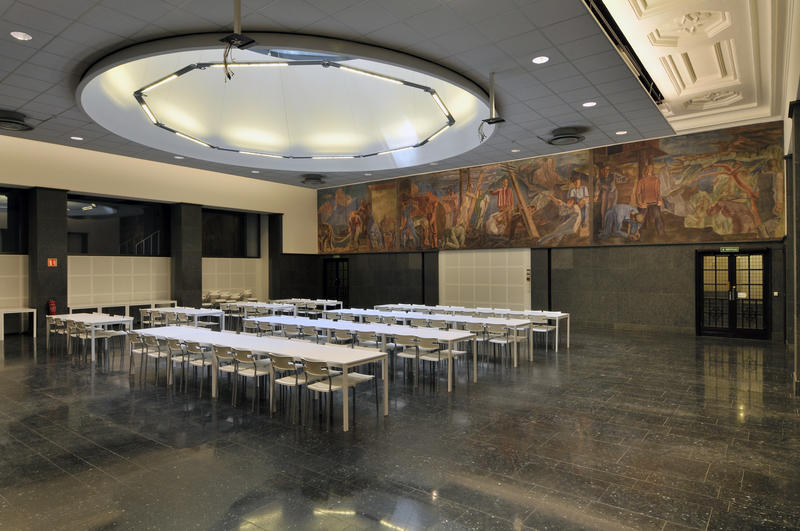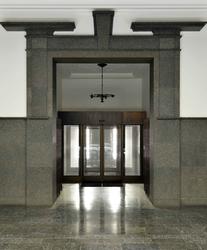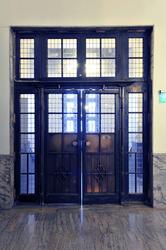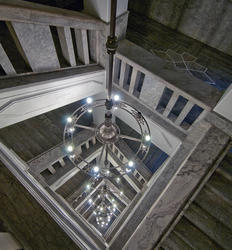We are in Oslo’s oldest district; this is the part of the city founded by King Chistian IV after the city fire in 1624. In contrast to the rest of the city with its less rigid road network, the streets here are laid out in a tight grid. For a long time, this was the city centre, the Christiania proper. As the city grew, however, the centre moved, and the quarter was overtaken by the business sector, important administrations buildings and cultural institutions.
- 1/6
Telegraph building, Kongensgate 21 Cato Normann/Telemuseet - 2/6
Interior, 1952 Ukjent/Telemuseet - 3/6
Exterior, 1930 Ukjent/Telemuseet - 4/6
Exterior, 1920ties Anders Beer Wilse - 5/6
Additional building from 1966. Cato Normann/Telemuseet - 6/6
Dome of light in the public hall Cato Normann/Telemuseet
Approximately in the centre of this square, in the crossing between Prinsens Gate and Kongens Gate, there is a towering colossus. 2140 sq. metres covered in heavy, grey granite. The windows on the ground floor are placed high up on the wall, and are protected by black, iron bars, and there’s just a sober, lit-up sign revealing exactly what building we’re standing in front of: “TELEGRAF TELEFON.” This was the main seat of Telenor, and up to the mid-nineties, the country’s most important telecoms exchange. This was truly where it was happening. This place received messages of war and of peace, and it was through here that Norway made contact with the world abroad. And then there were all the small, private conversations. There were hundreds of switchboard operators, working in dense formation, connecting people. 19 departments from the Oslo district were gathered under one roof when the Telegraph building was opened in January 1924.
-
Public entrance Cato Normann/Telemuseet
It was, however, not easy to have a new telegraph building erected in the capital. The process from start to finish involved both the Parliament and ministers, and at one point there were even rumours about a crisis in the government. All this happened because Telegraph Director Rasmussen already in 1899 bought the building plot without seeking approval from the Parliament. The press struck out at the Telegraph Director and at the minister, Nysom, who it was alleged had given Rasmussen the permission to secure the plot. “A dangerous man” read the newspaper, Farmand, describing Telenor’s (Den Norske Rigstelegraf) boss, while the opposition in Parliament pounded away at minister Nysom for two days solid. The property deal was still approved by a majority of the elected on 26 March 1900. By this time both Televerket and the department were so frightened by the entire ruckus, that the building plans were postponed. It wasn't till 19 years after the death of Rasmussen, in 1905, that his plans for a new telegraph building in Kvadraturen became a reality.
It might be seen as a bit unfair that the building has gone down in history as “a beautiful monument of Telegraph Director Heftye’s initiative,” but Thomas Heftye was after all the man who realised the building plans. Due to the increased traffic pressure since the plot had been purchased in Rasmussen’s time, Telenor (Norges Telegrafvæsen), with Heftye in the forefront, bought the whole quarter, Kongens Gate, Prinsens Gate, Nedre Slottsgate and Tollbugata. From now on it would be known as “Telekvartalet” (the Tele Quarter). This time the press had a more positive attitude: “It is well known that the telegraph- and the telephone services work under despairing conditions, so it is important to secure all possible speed in erecting the new building,” wrote the newspaper, Aftenposten on 6 May 1916. In 1917 the demolition of the surrounding structures started, and in 1922 part of the freshly constructed building could be taken into use.
-
Public hall Cato Normann/Telemuseet
"One of the most beautiful buildings in Kristiania"
The press loved it. Even if the final price tag came to a whopping 13 million NOK, Aftenposten concluded that this was “money well spent.” In another newspaper, Morgenbladet, it read:
The new telephone and telegraph building is undoubtedly one of the most beautiful buildings in Kristiania. It has not been granted an open position so that one may, unhindered, see its physiognomy, but stand underneath its walls while letting the gaze glide across the discreet grey architecture all the way up to the rusty slate on top, and it gives a serene satisfaction which characterizes it as completely successful.
Behind the building, which according to town antiquarian, Janne Wilberg, has been kept in a kind of Nordic neo-baroque style, were two young, aspiring architects, Arnstein Arneberg and Magnus Poulsson. The two architects would leave their mark on Oslo. While the telegraph building was being erected, Arneberg and Poulsson were in full swing designing the new Oslo City Hall with surrounding areas. Just like the City Hall, the giant over in Kongens Gate 21 is characterized by a richness of detail and a quality of materials. In the stairway we find a chandelier which at some point was the largest in Norway, and the feature wall in the reception hall is decorated in frescoes painted by the artist, Alf Rolfsen. The façade is clad in Norwegian granite, while Norwegian marble has been used in the interior, and concrete for the floors. For security reasons the building is more or less devoid of wood. This is also the reasoning behind the high hanging, prison-like windows. In a potential attack by enemy forces, there would be no doubt where they would hit first; the nerve centre of all the country’s communication. The Norwegian Telecom Museum is in possession of images showing German soldiers guarding the entrance to Kongens Gate 21.
- 1/4
Cato Normann/Telemuseet - 2/4
- 3/4
Cato Normann/Telemuseet - 4/4
Cato Normann/Telemuseet
More than one million cables were left when operations ended in the Telegraph Building in the 1990s. The time for manually connecting domestic- and international calls was long gone, and Telenor started a new chapter in the company’s history from new premises at Fornebu outside Oslo in 2002. The Telegraph Building was sold in November 2016 to Malling & Co and Vedal.
Sources
- Bestorp, Evert Oslo Telefonen 1880-1985, Oslo Teledistrikt
- Historiske linjer, Verneplan for Telenors bygninger og installasjoner, 1997
- Glenny, Alfsen (2009. februar, 13) (2009, 13. februar). Alf Rolfsen. The Norwegian Biographical Encyclopedia. Gathered 26 October 2016. Url: https://nbl.snl.no/Alf_Rolfsen
